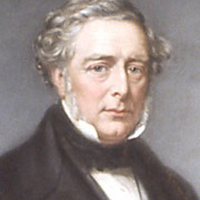Robert Stephenson
Robert Stephenson FRS HFRSE FRSA DCL was an English civil engineer and designer of locomotives. The only son of George Stephenson, the “Father of Railways”, he built on the achievements of his father. Robert has been called the greatest engineer of the 19th century.
Robert Stephenson built on the considerable achievements of his father, George. His forward thinking enabled the significant expansion of railways during the ‘railway mania’ of the mid nineteenth century. His expertise in both civil and mechanical engineering established the concept of the railway which developed in this country, and was then exported to the world.
Robert Stephenson, the only son of George Stephenson. Times were hard for the Stephenson family, often living in one room dwellings while George worked on various machines at different collieries and mills. Despite this, George made sure that Robert received a full education, the quality of which increased with the father’s fortunes. After leaving the Bruce Academy in Newcastle in 1819, the young Robert was taken on as an apprentice mining engineer at Killingworth Colliery. With his increasing understanding of engineering, he helped his father in surveying the Stockton & Darlington Railway line, experience which led him to assist in the first surveys of the Liverpool & Manchester Railway.
After the successful opening of both the Stockton & Darlington Railway and the Liverpool & Manchester Railway, Robert was in demand as a railway engineer. During the years of ‘railway mania’ during the 1830s and 1840s, he was appointed engineer to a great number of railways in the midlands, north of England and north Wales. His first major commission was the London & Birmingham Railway; opened in 1838 it was the first railway into London. With its terminus at Euston it went north west to Birmingham Curzon Street, forming a junction with the Grand Junction Railway and connecting the new line with the cities of Liverpool and Manchester. Works at Kilsby Tunnel (near Rugby) and the cuttings at Tring and Roade were major civil engineering undertakings. For the Chester & Holyhead Railway and the Newcastle & Berwick Railway he designed four very notable and different railway bridges, all of which are still in use today. The highly distinctive Conway (1848) and Britannia (1850) bridges in North Wales both incorporated box section wrought iron tubes. The High Level Bridge (1849), between Newcastle and Gateshead carried both a railway and a roadway from the outset on cast iron spans, while the Royal Border Bridge (1850) was a simple masonry structure.
Locomotives and the Rainhill Trials
Robert Stephenson & Co, Newcastle was established by George Stephenson in 1823, Robert being the firm’s managing partner. Foreseeing the demand for steam engines for the new railway, it was the first locomotive works in the world. The firm completed its first steam engine Locomotion just in time for the ceremonial opening of the Stockton & Darlington Railway in September 1825.
As early as 1822 while working on the Liverpool & Manchester Railway, Robert Stephenson strongly advocated the use of ‘travelling’ rather than fixed engines on the line, despite the preference of both the company directors and his father George for a fixed arrangement. After his return from South America in 1827, Robert found the question still under debate. The Directors proposed a competition to decide the best mode of traction for their new railway. Robert Stephenson & Co entered their locomotive Rocket into the Rainhill Trails in October 1829. It won, and convinced a watching world that locomotives were the future for the new railway. Robert Stephenson continued to improve on Rocket’s design, its multi-tubular boiler providing the template for steam locomotives built worldwide during the 19th and 20th centuries.
Railways for the world
With his growing reputation for railway engineering, both civil and mechanical, Robert Stephenson was able to travel abroad on various consultancies for overseas railways during the 1840s and 1850s. His most notable structures were all tubular bridges; the Victoria Bridge over the St Lawrence River in Montreal, and bridges over the Nile for the Egyptian Railway between Alexandria and Suez via Cairo. As either chief engineer or consultant to railway projects his work influenced the development of railways in Belgium, Switzerland, Norway, Denmark, Italy, and India. It is no coincidence that these railways made use of the Stephenson ‘standard’ gauge and had locomotives designed and built by Robert Stephenson & Co, Newcastle. By the time of his death, Robert Stephenson had received honours from many of the countries that had made use of his engineering talents; his vision of the railway had been taken to the world.

Robert Stephenson
Date of Birth: 16 Oct 1803
Birth Place: Willington Quay, Wallsend, United Kingdom
Proffession: Civil engineer
Nationality: United Kingdom
Death: 12 October 1859, London, United Kingdom


